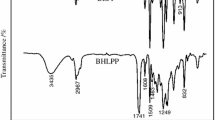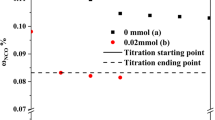Abstract
Novel polyurethanes with exactly controlled structures, that is, alternating block polyurethanes based on poly(propylene glycol) and poly(ethylene glycol) that are linked through urethane segments, were synthesized by polyaddition polymerization. A reaction between isocyanate groups from the poly(propylene glycol) tolylene 2,4-diisocyanate terminated component and the hydroxyl groups of the poly(ethylene glycol) component as a chain extender produced the controlled structure. The chemical structure was characterized by nuclear magnetic resonance spectra, Fourier transform infrared spectroscopy, and varying poly(ethylene glycol) molecular weights. The thermal property was investigated by differential scanning calorimetry and thermogravimetric analysis. The wettability was studied using the static contact angle of water. These polymers exhibit remarkable crystallization features and very good dispersion in water. The presence of urethane segments on the molecular chains provides good stability for the dispersion in water. The obtained polymers possess good thermal properties. Differential scanning calorimetry and polarized optical microscopy revealed improved dispersion in water and increased crystallization capability in correlation with the increase of the PEG molecular weight. These polyurethanes would be promising candidates for friendly environmental polymer materials.
Graphical Abstract











Similar content being viewed by others
Data Availability
Not Applicable.
Code Availability
Not Applicable.
References
Cheng B-X, Lu C-C, Li Q, Zhao S-Q, Bi C-S, Wu W, Huang C-X, Zhao H (2022) Preparation and properties of self-healing triboelectric nanogenerator based on waterborne polyurethane containing Diels-Alder bonds. J Polym Environ 30:5252–5262
Xu J, Xiao W, Zhang S, Dong Z, Lei C (2022) Synthesis and characterization of polyurethane with poly(ether-ester) diols soft segments consisted by ether and ester linkages in one repeating unit. Eur Polym J 179:111553
Chen Y, Yan J, Zhang Y, Chen W, Wang Z, Wang L (2022) Synthesis, characterization and antibacterial activity of novel β-cyclodextrin polyurethane materials. J Polym Environ 30:1012–1027
Polo Fonseca L, Felisberti, (2021) Thermo- and UV-responsive amphiphilic nanogels via reversible [4+4] photocycloaddition of PEG/PCL-based polyurethane dispersions. Eur Polym J 160:110800
Glowinska E, Wolak W, Datta J (2021) Eco-friendly route for thermoplastic polyurethane elastomers with bio-based hard segments composed of bio-glycol and mixtures of aromatic–aliphatic and aliphatic–aliphatic diisocyanate. J Polym Environ 29:2140–2149
Oprea S, Potolinca VO, Oprea V (2021) New polyurethanes with specific dielectric behavior through included of 1,3,4-thiadiazole derivative in their structure. Eur Polym J 143:110177
Oprea S, Potolinca V-O, Oprea V (2016) Synthesis and properties of new crosslinked polyurethane elastomers based on isosorbide. Eur Polym J 83:161–172
Etxaniz I, Llorente O, Aizpurua J, Martin L, Gonzalez A, Irusta L (2019) Dispersion characteristics and curing behaviour of waterborne UV crosslinkable polyurethanes based on renewable dimer fatty acid polyesters. J Polym Environ 27:189–197
Wondu E, Oh HW, Kim J (2019) Effect of DMPA and molecular weight of polyethylene glycol on water-soluble polyurethane. Polymers (Basel) 11:1915
Wondu E, Lule ZC, Kim J (2020) Fabrication of aliphatic water-soluble polyurethane composites with silane treated CaCO3. Polymers (Basel) 12:747
Krol P, Krol B (2020) Structures, properties and applications of the polyurethane ionomers. J Mater Sci 55:73–87
Santamaria-Echart A, Ugarte L, García-Astrain C, Arbelaiz A, Corcuera MA, Eceiza A (2016) Cellulose nanocrystals reinforced environmentally-friendly waterborne polyurethane nanocomposites. Carbohydr Polym 151:1203–1209
Zhou X, Li Y, Fang C, Li S, Cheng Y, Lei W, Meng X (2015) Recent advances in synthesis of waterborne polyurethane and their application in water-based ink: a review. J Mater Sci Technol 31:708–722
Honarkar H (2018) Waterborne polyurethanes: a review. J Dispers Sci Technol 39:507–516
Feng Q, Chen G, Liang J (2018) The preparation method of nonionic waterborne polyurethane. Model Meas Control C 79:222–228
Heath R, Rungvichaniwat A (2002) The examination of the structure property relationships of some water-dispersed polyurethane elastomers. Prog Rubber Plast Recycl Technol 18:1–47
Cheong IW, Nomura M, Kim JH (2000) Synthesis and aqueous solution behavior of water-soluble polyurethane (IPDI-PPG-DMPA) resin. Macromol Chem Phys 201:2221–2227
Jaudouin O, Robin J, Lopez-Cuesta J-M, Perrin D, Imbert C (2012) Ionomer based polyurethanes a comparative study of properties and applications. Polym Int 61:495–510
Kuok AME, Sipaut CS, Sundang M (2019) Synthesis and characterisation of new water-based polyurethane dispersion via solvent-free prepolymer mixing process. J Phys Conf Ser 1358:012039
Mumtaz F, Zuber M, Zia KM, Jamil T, Hussain R (2013) Synthesis and properties of aqueous polyurethane dispersions: Influence of molecular weight of polyethylene glycol. Korean J Chem Eng 30:2259–2263
Qiao ZY, Du FS, Zhang R, Liang DH, Li ZC (2010) Biocompatible thermoresponsive polymers with pendent oligo(ethylene glycol) chains and cyclic ortho ester groups. Macromolecules 43:6485–6494
Albers PTM, Van Der Ven LGJ, Van Benthem RATM, Esteves ACC, De With G (2020) Water swelling behavior of poly(ethylene glycol)-based polyurethane networks. Macromolecules 53:862–874
Hamley IW, Krysmann MJ (2008) Effect of PEG crystallization on the self-assembly of PEG/peptide copolymers containing amyloid peptide fragments. Langmuir 24:8210–8214
Gonzalez-Fernandez D, Torneiro M, Lazzari M (2020) Some guidelines for the synthesis and melting characterization of azide poly(ethylene glycol) derivatives. Polymers (Basel) 12:1269
Yang Z, Wu G (2020) Effects of soft segment characteristics on the properties of biodegradable amphiphilic waterborne polyurethane prepared by a green process. J Mater Sci 55:3139–3156
Arevalo-Alquichire S, Morales-Gonzalez M, Navas-Gomez K, Diaz LE, Gomez-Tejedor JA, Serrano MA, Valero MF (2020) Influence of polyol/crosslinker blend composition on phase separation and thermo-mechanical properties of polyurethane thin films. Polymers (Basel) 12:666
Francolini I, Silvestro I, Di Lisio V, Martinelli A, Piozzi A (2019) Synthesis, characterization, and bacterial fouling-resistance properties of polyethylene glycol-grafted polyurethane elastomers. Int J Mol Sci 20:1001
Oprea S (2011) Effect of the long chain extender on the properties of linear and castor oil cross-linked PEG-based polyurethane elastomers. J Mater Sci 46:2251–2258
Corneillie S, Lan PN, Schacht E, Davies M, Shard A, Green R, Denyer S, Wassall M, Whitfield H, Choong S (1998) Polyethylene glycol-containing polyurethanes for biomedical applications. Polym Int 46:251–259
Doseva V, Shenkov S, Vasilev S, Baranovsky VY (2004) Synthesis and properties of water soluble polyurethanes based on poly(ethylene glycol). J Appl Polym Sci 91:3651–3658
Sundararajan S, Samui AB, Kulkarni PS (2017) Synthesis and characterization of poly(ethylene glycol) (PEG) based hyperbranched polyurethanes as thermal energy storage materials. Thermochim Acta 650:114–122
Kadajji VG, Betageri GV (2011) Water soluble polymers for pharmaceutical applications. Polymers (Basel) 3:1972–2009
Alswieleh AM, Cheng N, Leggett GJ, Armes SP (2014) Spatial control over cross-linking dictates the pH-responsive behavior of poly(2-(tert -butylamino)ethyl methacrylate) brushes. Langmuir 30:1391–1400
Li H, Sun JT, Wang C, Liu S, Yuan D, Zhou X, Tan J, Stubbs L, He C (2017) High modulus, strength, and toughness polyurethane elastomer based on unmodified lignin. ACS Sustain Chem Eng 5:7942–7949
Xia H, Song M, Jin J, Chen L (2006) Poly(propylene glycol)-grafted multi-walled carbon nanotube polyurethane. Macromol Chem Phys 207:1945–1952
Campos E, Cordeiro R, Alves P, Rasteiro MG, Gil MH (2008) Polyurethane-based microparticles: formulation and influence of processes variables on its characteristics. J Microencapsul 25:154–169
Kupka V, Vojtova L, Fohlerova Z, Jancar J (2016) Solvent free synthesis and structural evaluation of polyurethane films based on poly(ethylene glycol) and poly(caprolactone). Express Polym Lett 10:479–492
Pegoraro M, Galbiati A, Ricca G (2003) 1H nuclear magnetic resonance study of polyurethane prepolymers from toluene diisocyanate and polypropylene glycol. J Appl Polym Sci 87:347–357
Prabhakar A, Chattopadhyay DK, Jagadeesh B, Raju KVSN (2005) Structural investigations of polypropylene glycol (PPG) and isophorone diisocyanate (IPDI)-based polyurethane prepolymer by 1D and 2D NMR spectroscopy. J Polym Sci Part A Polym Chem 43:1196–1209
Numata K, Asano A, Nakazawa Y (2020) Solid-state and time domain NMR to elucidate degradation behavior of thermally aged poly(urea-urethane). Polym Degrad Stab 172:109052
He Y, Zhang X, Zhang X, Huang H, Chang J, Chen H (2012) Structural investigations of toluene diisocyanate (TDI) and trimethylolpropane (TMP)-based polyurethane prepolymer. J Ind Eng Chem 18:1620–1627
Oprea S, Potolinca VO, Oprea V (2018) Influence of the hydroquinone ether moieties and bisphenol a glycerolate diacrylate on the UV stability behavior of new polyurethane materials. J Polym Res 25:79
Somdee P, Lassu-Kuknyo T, Konya C, Szabo T, Marossy K (2019) Thermal analysis of polyurethane elastomers matrix with different chain extender contents for thermal conductive application. J Therm Anal Calorim 138:1003–1010
Zhou G, Ma C, Zhang G (2011) Synthesis of polyurethane-g-poly(ethylene glycol) copolymers by macroiniferter and their protein resistance. Polym Chem 2:1409–1414
Asensio M, Costa V, Nohales A, Bianchi O, Gomez CM (2019) Tunable structure and properties of segmented thermoplastic polyurethanes as a function of flexible segment. Polymers (Basel) 11:1910
Owens DK, Wendt RC (1969) Estimation of the surface free energy of polymers. J Appl Polym Sci 13:1741–1747
Mccormick CL (1991) Structural design of water-soluble copolymers. ACS Symp Ser 467:2–24
Li Y, Ma Q, Huang C, Liu G (2013) Crystallization of poly(ethylene glycol) in poly(methyl methacrylate) networks. Mater Sci 19:147–151
Author information
Authors and Affiliations
Contributions
All authors have equal contribution to the paper. The corresponding author is responsible for ensuring that the descriptions are accurate and agreed by all authors.
Corresponding authors
Ethics declarations
Competing interest
The authors declare no competing interests.
Additional information
Publisher's Note
Springer Nature remains neutral with regard to jurisdictional claims in published maps and institutional affiliations.
Rights and permissions
Springer Nature or its licensor (e.g. a society or other partner) holds exclusive rights to this article under a publishing agreement with the author(s) or other rightsholder(s); author self-archiving of the accepted manuscript version of this article is solely governed by the terms of such publishing agreement and applicable law.
About this article
Cite this article
Oprea, S., Potolinca, V.O. Water-Dispersible Polyurethanes Obtained by the Controlled Alternation of the Segments of Poly(propylene glycol), Poly(ethylene glycol) and Urethane. J Polym Environ 31, 3754–3767 (2023). https://doi.org/10.1007/s10924-023-02851-9
Accepted:
Published:
Issue Date:
DOI: https://doi.org/10.1007/s10924-023-02851-9




